ENGL 101: The Ethical Implications of Animal Testing and Research
VerifiedAdded on 2022/02/07
|5
|1780
|40
Essay
AI Summary
This essay argues against the use of animals in research and product testing, asserting that it violates animal rights, inflicts unnecessary pain and suffering, and is no longer justifiable due to the availability of alternative testing methods. The author highlights the inherent moral value of animals, drawing on philosophical arguments to support the claim that animals deserve respectful treatment. The essay critiques common animal testing procedures like the Draize and LD50 tests, emphasizing the intense pain and suffering they cause. Furthermore, it champions the adoption of cruelty-free alternatives such as synthetic tissues, computer simulations, and in vitro testing. The author refutes counterarguments that animal testing is necessary for human safety or benefits animals themselves, concluding that animal testing should be eliminated in favor of more ethical and humane practices. Desklib provides access to similar essays and study resources for students.
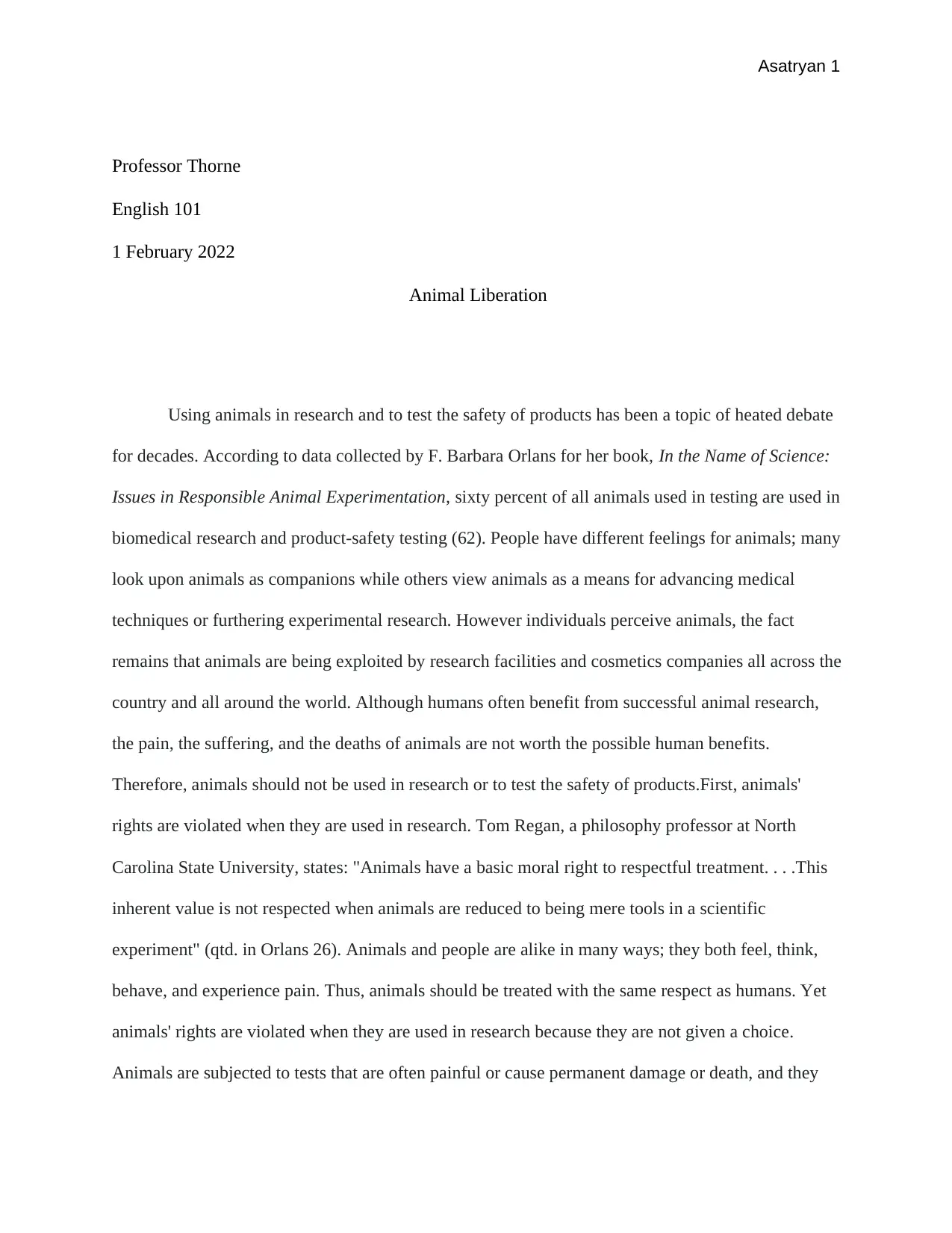
Asatryan 1
Professor Thorne
English 101
1 February 2022
Animal Liberation
Using animals in research and to test the safety of products has been a topic of heated debate
for decades. According to data collected by F. Barbara Orlans for her book, In the Name of Science:
Issues in Responsible Animal Experimentation, sixty percent of all animals used in testing are used in
biomedical research and product-safety testing (62). People have different feelings for animals; many
look upon animals as companions while others view animals as a means for advancing medical
techniques or furthering experimental research. However individuals perceive animals, the fact
remains that animals are being exploited by research facilities and cosmetics companies all across the
country and all around the world. Although humans often benefit from successful animal research,
the pain, the suffering, and the deaths of animals are not worth the possible human benefits.
Therefore, animals should not be used in research or to test the safety of products.First, animals'
rights are violated when they are used in research. Tom Regan, a philosophy professor at North
Carolina State University, states: "Animals have a basic moral right to respectful treatment. . . .This
inherent value is not respected when animals are reduced to being mere tools in a scientific
experiment" (qtd. in Orlans 26). Animals and people are alike in many ways; they both feel, think,
behave, and experience pain. Thus, animals should be treated with the same respect as humans. Yet
animals' rights are violated when they are used in research because they are not given a choice.
Animals are subjected to tests that are often painful or cause permanent damage or death, and they
Professor Thorne
English 101
1 February 2022
Animal Liberation
Using animals in research and to test the safety of products has been a topic of heated debate
for decades. According to data collected by F. Barbara Orlans for her book, In the Name of Science:
Issues in Responsible Animal Experimentation, sixty percent of all animals used in testing are used in
biomedical research and product-safety testing (62). People have different feelings for animals; many
look upon animals as companions while others view animals as a means for advancing medical
techniques or furthering experimental research. However individuals perceive animals, the fact
remains that animals are being exploited by research facilities and cosmetics companies all across the
country and all around the world. Although humans often benefit from successful animal research,
the pain, the suffering, and the deaths of animals are not worth the possible human benefits.
Therefore, animals should not be used in research or to test the safety of products.First, animals'
rights are violated when they are used in research. Tom Regan, a philosophy professor at North
Carolina State University, states: "Animals have a basic moral right to respectful treatment. . . .This
inherent value is not respected when animals are reduced to being mere tools in a scientific
experiment" (qtd. in Orlans 26). Animals and people are alike in many ways; they both feel, think,
behave, and experience pain. Thus, animals should be treated with the same respect as humans. Yet
animals' rights are violated when they are used in research because they are not given a choice.
Animals are subjected to tests that are often painful or cause permanent damage or death, and they
Paraphrase This Document
Need a fresh take? Get an instant paraphrase of this document with our AI Paraphraser
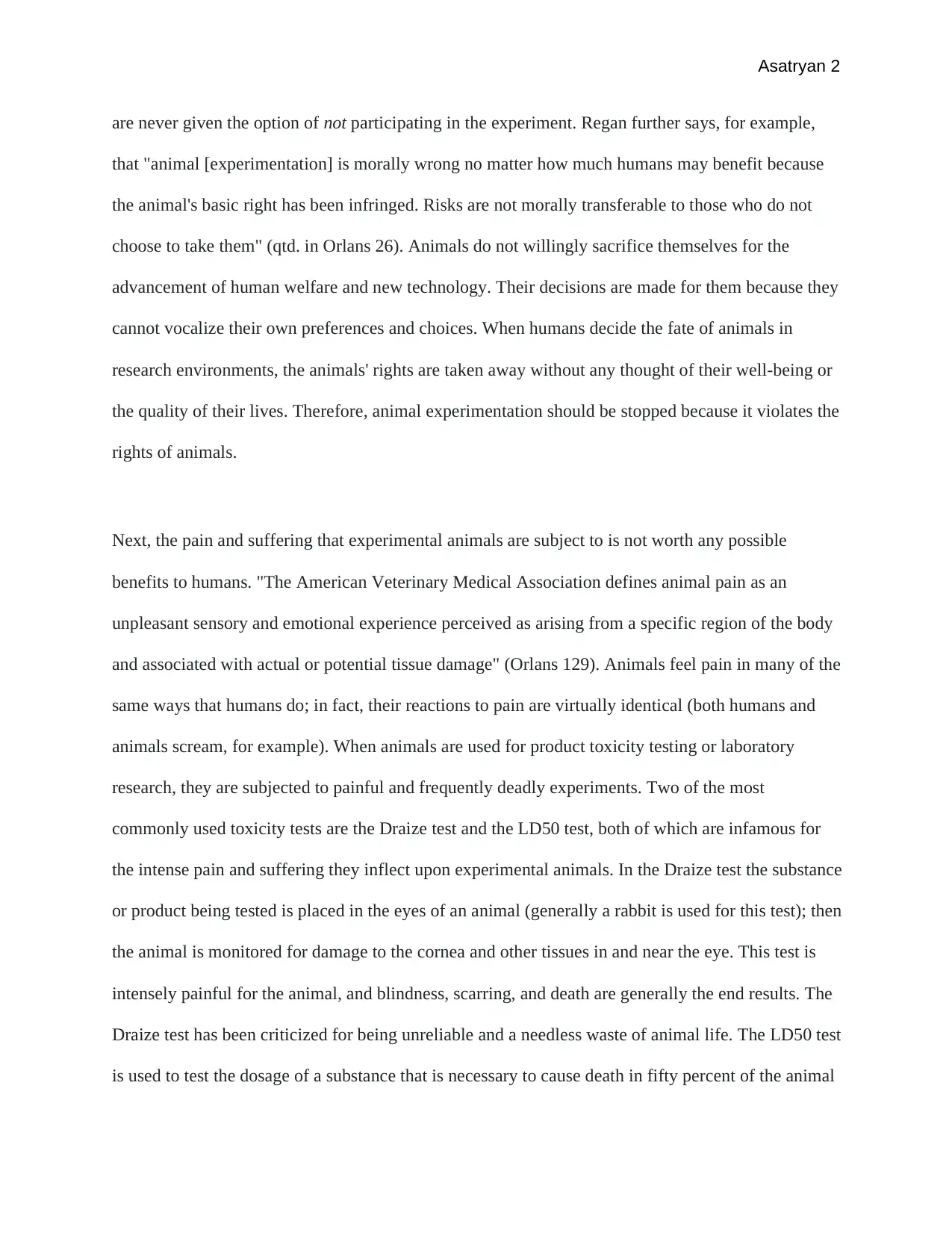
Asatryan 2
are never given the option of not participating in the experiment. Regan further says, for example,
that "animal [experimentation] is morally wrong no matter how much humans may benefit because
the animal's basic right has been infringed. Risks are not morally transferable to those who do not
choose to take them" (qtd. in Orlans 26). Animals do not willingly sacrifice themselves for the
advancement of human welfare and new technology. Their decisions are made for them because they
cannot vocalize their own preferences and choices. When humans decide the fate of animals in
research environments, the animals' rights are taken away without any thought of their well-being or
the quality of their lives. Therefore, animal experimentation should be stopped because it violates the
rights of animals.
Next, the pain and suffering that experimental animals are subject to is not worth any possible
benefits to humans. "The American Veterinary Medical Association defines animal pain as an
unpleasant sensory and emotional experience perceived as arising from a specific region of the body
and associated with actual or potential tissue damage" (Orlans 129). Animals feel pain in many of the
same ways that humans do; in fact, their reactions to pain are virtually identical (both humans and
animals scream, for example). When animals are used for product toxicity testing or laboratory
research, they are subjected to painful and frequently deadly experiments. Two of the most
commonly used toxicity tests are the Draize test and the LD50 test, both of which are infamous for
the intense pain and suffering they inflect upon experimental animals. In the Draize test the substance
or product being tested is placed in the eyes of an animal (generally a rabbit is used for this test); then
the animal is monitored for damage to the cornea and other tissues in and near the eye. This test is
intensely painful for the animal, and blindness, scarring, and death are generally the end results. The
Draize test has been criticized for being unreliable and a needless waste of animal life. The LD50 test
is used to test the dosage of a substance that is necessary to cause death in fifty percent of the animal
are never given the option of not participating in the experiment. Regan further says, for example,
that "animal [experimentation] is morally wrong no matter how much humans may benefit because
the animal's basic right has been infringed. Risks are not morally transferable to those who do not
choose to take them" (qtd. in Orlans 26). Animals do not willingly sacrifice themselves for the
advancement of human welfare and new technology. Their decisions are made for them because they
cannot vocalize their own preferences and choices. When humans decide the fate of animals in
research environments, the animals' rights are taken away without any thought of their well-being or
the quality of their lives. Therefore, animal experimentation should be stopped because it violates the
rights of animals.
Next, the pain and suffering that experimental animals are subject to is not worth any possible
benefits to humans. "The American Veterinary Medical Association defines animal pain as an
unpleasant sensory and emotional experience perceived as arising from a specific region of the body
and associated with actual or potential tissue damage" (Orlans 129). Animals feel pain in many of the
same ways that humans do; in fact, their reactions to pain are virtually identical (both humans and
animals scream, for example). When animals are used for product toxicity testing or laboratory
research, they are subjected to painful and frequently deadly experiments. Two of the most
commonly used toxicity tests are the Draize test and the LD50 test, both of which are infamous for
the intense pain and suffering they inflect upon experimental animals. In the Draize test the substance
or product being tested is placed in the eyes of an animal (generally a rabbit is used for this test); then
the animal is monitored for damage to the cornea and other tissues in and near the eye. This test is
intensely painful for the animal, and blindness, scarring, and death are generally the end results. The
Draize test has been criticized for being unreliable and a needless waste of animal life. The LD50 test
is used to test the dosage of a substance that is necessary to cause death in fifty percent of the animal
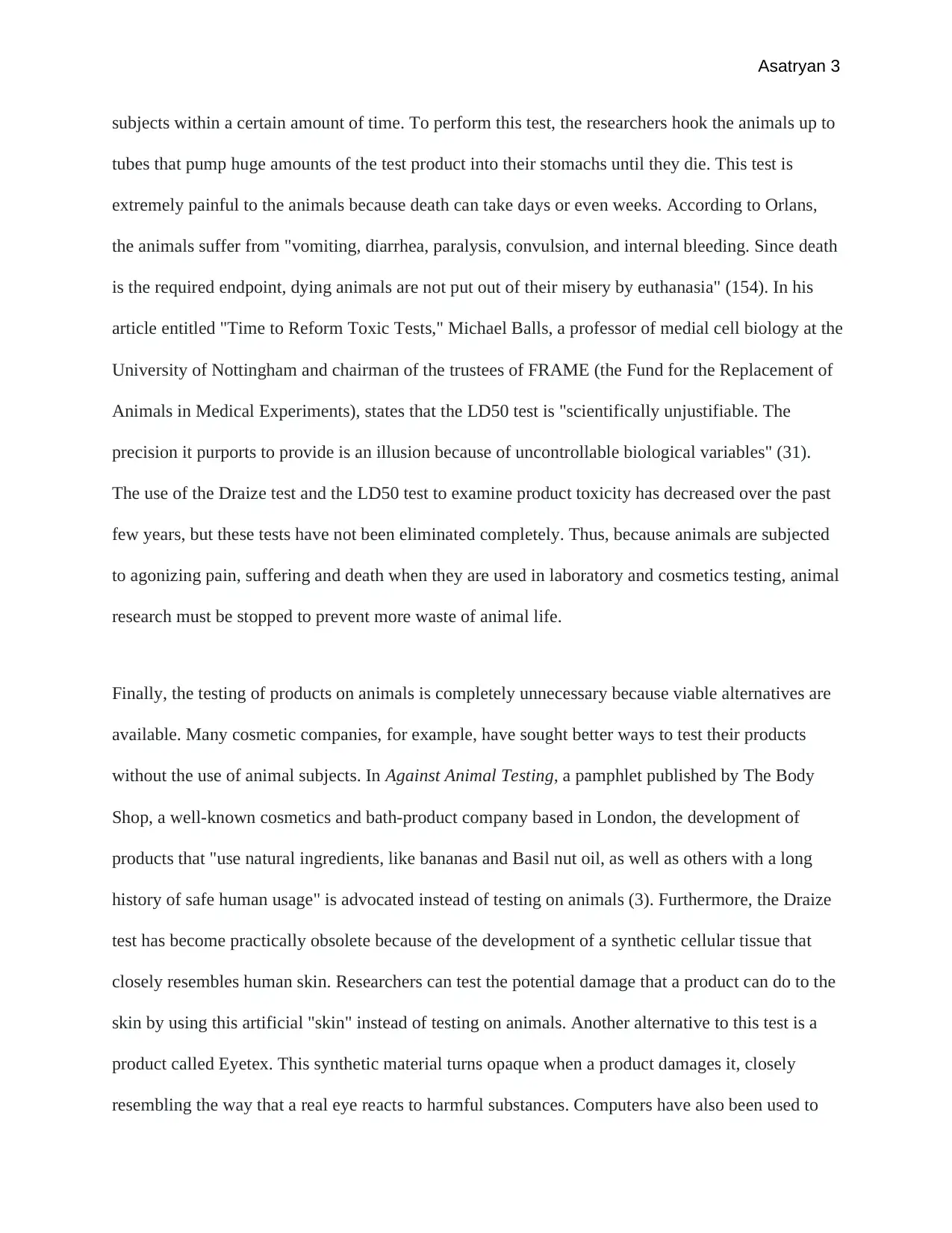
Asatryan 3
subjects within a certain amount of time. To perform this test, the researchers hook the animals up to
tubes that pump huge amounts of the test product into their stomachs until they die. This test is
extremely painful to the animals because death can take days or even weeks. According to Orlans,
the animals suffer from "vomiting, diarrhea, paralysis, convulsion, and internal bleeding. Since death
is the required endpoint, dying animals are not put out of their misery by euthanasia" (154). In his
article entitled "Time to Reform Toxic Tests," Michael Balls, a professor of medial cell biology at the
University of Nottingham and chairman of the trustees of FRAME (the Fund for the Replacement of
Animals in Medical Experiments), states that the LD50 test is "scientifically unjustifiable. The
precision it purports to provide is an illusion because of uncontrollable biological variables" (31).
The use of the Draize test and the LD50 test to examine product toxicity has decreased over the past
few years, but these tests have not been eliminated completely. Thus, because animals are subjected
to agonizing pain, suffering and death when they are used in laboratory and cosmetics testing, animal
research must be stopped to prevent more waste of animal life.
Finally, the testing of products on animals is completely unnecessary because viable alternatives are
available. Many cosmetic companies, for example, have sought better ways to test their products
without the use of animal subjects. In Against Animal Testing, a pamphlet published by The Body
Shop, a well-known cosmetics and bath-product company based in London, the development of
products that "use natural ingredients, like bananas and Basil nut oil, as well as others with a long
history of safe human usage" is advocated instead of testing on animals (3). Furthermore, the Draize
test has become practically obsolete because of the development of a synthetic cellular tissue that
closely resembles human skin. Researchers can test the potential damage that a product can do to the
skin by using this artificial "skin" instead of testing on animals. Another alternative to this test is a
product called Eyetex. This synthetic material turns opaque when a product damages it, closely
resembling the way that a real eye reacts to harmful substances. Computers have also been used to
subjects within a certain amount of time. To perform this test, the researchers hook the animals up to
tubes that pump huge amounts of the test product into their stomachs until they die. This test is
extremely painful to the animals because death can take days or even weeks. According to Orlans,
the animals suffer from "vomiting, diarrhea, paralysis, convulsion, and internal bleeding. Since death
is the required endpoint, dying animals are not put out of their misery by euthanasia" (154). In his
article entitled "Time to Reform Toxic Tests," Michael Balls, a professor of medial cell biology at the
University of Nottingham and chairman of the trustees of FRAME (the Fund for the Replacement of
Animals in Medical Experiments), states that the LD50 test is "scientifically unjustifiable. The
precision it purports to provide is an illusion because of uncontrollable biological variables" (31).
The use of the Draize test and the LD50 test to examine product toxicity has decreased over the past
few years, but these tests have not been eliminated completely. Thus, because animals are subjected
to agonizing pain, suffering and death when they are used in laboratory and cosmetics testing, animal
research must be stopped to prevent more waste of animal life.
Finally, the testing of products on animals is completely unnecessary because viable alternatives are
available. Many cosmetic companies, for example, have sought better ways to test their products
without the use of animal subjects. In Against Animal Testing, a pamphlet published by The Body
Shop, a well-known cosmetics and bath-product company based in London, the development of
products that "use natural ingredients, like bananas and Basil nut oil, as well as others with a long
history of safe human usage" is advocated instead of testing on animals (3). Furthermore, the Draize
test has become practically obsolete because of the development of a synthetic cellular tissue that
closely resembles human skin. Researchers can test the potential damage that a product can do to the
skin by using this artificial "skin" instead of testing on animals. Another alternative to this test is a
product called Eyetex. This synthetic material turns opaque when a product damages it, closely
resembling the way that a real eye reacts to harmful substances. Computers have also been used to
⊘ This is a preview!⊘
Do you want full access?
Subscribe today to unlock all pages.

Trusted by 1+ million students worldwide
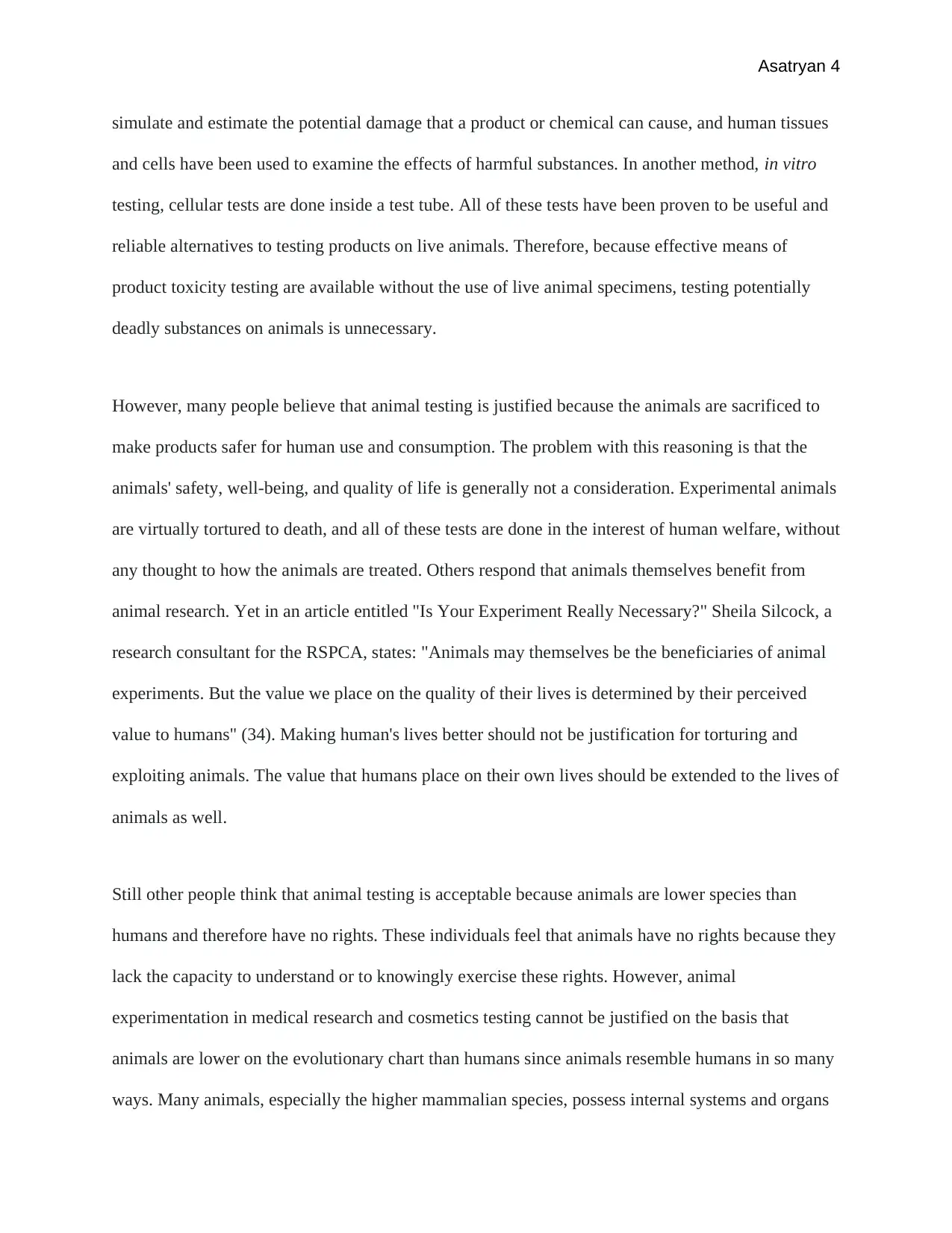
Asatryan 4
simulate and estimate the potential damage that a product or chemical can cause, and human tissues
and cells have been used to examine the effects of harmful substances. In another method, in vitro
testing, cellular tests are done inside a test tube. All of these tests have been proven to be useful and
reliable alternatives to testing products on live animals. Therefore, because effective means of
product toxicity testing are available without the use of live animal specimens, testing potentially
deadly substances on animals is unnecessary.
However, many people believe that animal testing is justified because the animals are sacrificed to
make products safer for human use and consumption. The problem with this reasoning is that the
animals' safety, well-being, and quality of life is generally not a consideration. Experimental animals
are virtually tortured to death, and all of these tests are done in the interest of human welfare, without
any thought to how the animals are treated. Others respond that animals themselves benefit from
animal research. Yet in an article entitled "Is Your Experiment Really Necessary?" Sheila Silcock, a
research consultant for the RSPCA, states: "Animals may themselves be the beneficiaries of animal
experiments. But the value we place on the quality of their lives is determined by their perceived
value to humans" (34). Making human's lives better should not be justification for torturing and
exploiting animals. The value that humans place on their own lives should be extended to the lives of
animals as well.
Still other people think that animal testing is acceptable because animals are lower species than
humans and therefore have no rights. These individuals feel that animals have no rights because they
lack the capacity to understand or to knowingly exercise these rights. However, animal
experimentation in medical research and cosmetics testing cannot be justified on the basis that
animals are lower on the evolutionary chart than humans since animals resemble humans in so many
ways. Many animals, especially the higher mammalian species, possess internal systems and organs
simulate and estimate the potential damage that a product or chemical can cause, and human tissues
and cells have been used to examine the effects of harmful substances. In another method, in vitro
testing, cellular tests are done inside a test tube. All of these tests have been proven to be useful and
reliable alternatives to testing products on live animals. Therefore, because effective means of
product toxicity testing are available without the use of live animal specimens, testing potentially
deadly substances on animals is unnecessary.
However, many people believe that animal testing is justified because the animals are sacrificed to
make products safer for human use and consumption. The problem with this reasoning is that the
animals' safety, well-being, and quality of life is generally not a consideration. Experimental animals
are virtually tortured to death, and all of these tests are done in the interest of human welfare, without
any thought to how the animals are treated. Others respond that animals themselves benefit from
animal research. Yet in an article entitled "Is Your Experiment Really Necessary?" Sheila Silcock, a
research consultant for the RSPCA, states: "Animals may themselves be the beneficiaries of animal
experiments. But the value we place on the quality of their lives is determined by their perceived
value to humans" (34). Making human's lives better should not be justification for torturing and
exploiting animals. The value that humans place on their own lives should be extended to the lives of
animals as well.
Still other people think that animal testing is acceptable because animals are lower species than
humans and therefore have no rights. These individuals feel that animals have no rights because they
lack the capacity to understand or to knowingly exercise these rights. However, animal
experimentation in medical research and cosmetics testing cannot be justified on the basis that
animals are lower on the evolutionary chart than humans since animals resemble humans in so many
ways. Many animals, especially the higher mammalian species, possess internal systems and organs
Paraphrase This Document
Need a fresh take? Get an instant paraphrase of this document with our AI Paraphraser
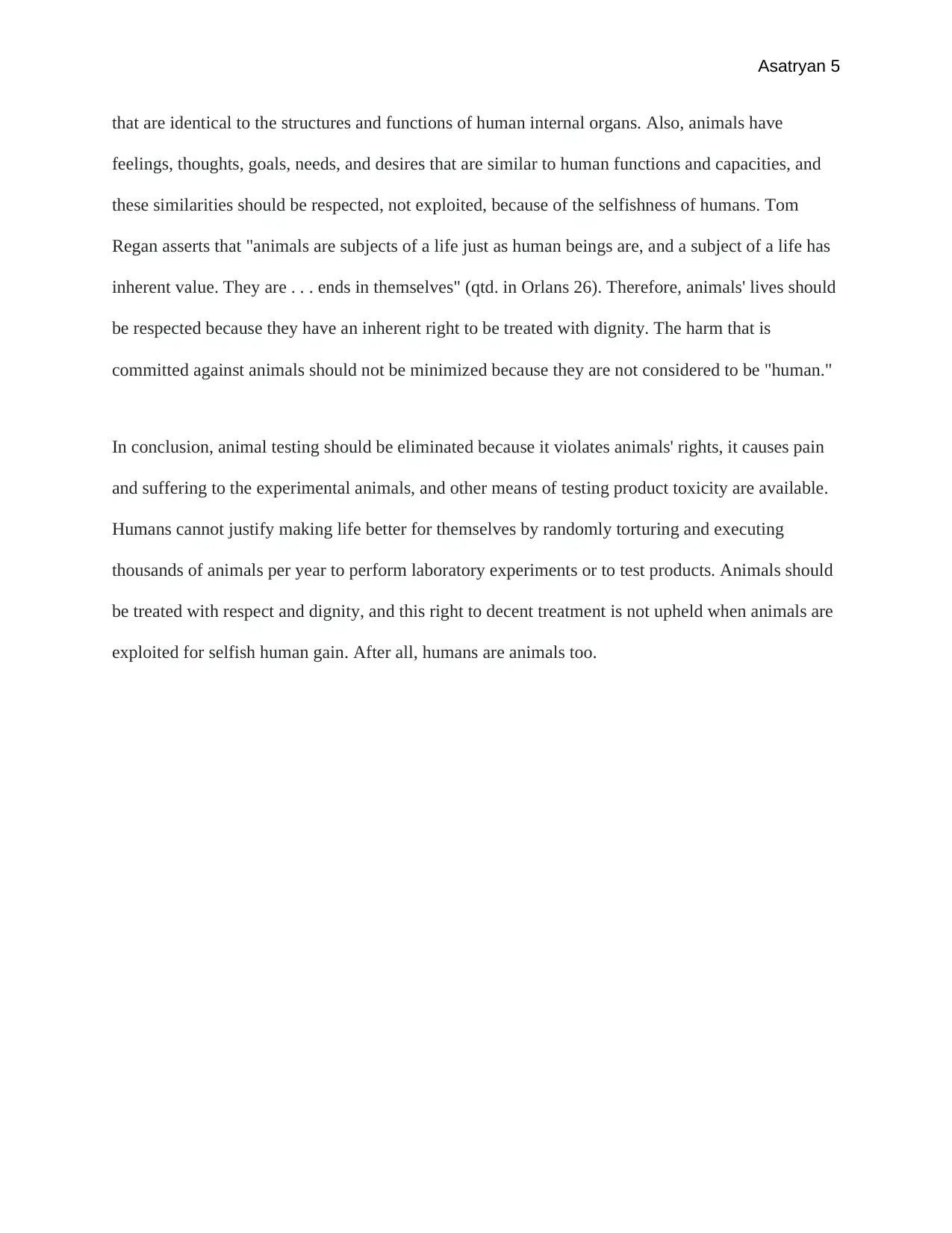
Asatryan 5
that are identical to the structures and functions of human internal organs. Also, animals have
feelings, thoughts, goals, needs, and desires that are similar to human functions and capacities, and
these similarities should be respected, not exploited, because of the selfishness of humans. Tom
Regan asserts that "animals are subjects of a life just as human beings are, and a subject of a life has
inherent value. They are . . . ends in themselves" (qtd. in Orlans 26). Therefore, animals' lives should
be respected because they have an inherent right to be treated with dignity. The harm that is
committed against animals should not be minimized because they are not considered to be "human."
In conclusion, animal testing should be eliminated because it violates animals' rights, it causes pain
and suffering to the experimental animals, and other means of testing product toxicity are available.
Humans cannot justify making life better for themselves by randomly torturing and executing
thousands of animals per year to perform laboratory experiments or to test products. Animals should
be treated with respect and dignity, and this right to decent treatment is not upheld when animals are
exploited for selfish human gain. After all, humans are animals too.
that are identical to the structures and functions of human internal organs. Also, animals have
feelings, thoughts, goals, needs, and desires that are similar to human functions and capacities, and
these similarities should be respected, not exploited, because of the selfishness of humans. Tom
Regan asserts that "animals are subjects of a life just as human beings are, and a subject of a life has
inherent value. They are . . . ends in themselves" (qtd. in Orlans 26). Therefore, animals' lives should
be respected because they have an inherent right to be treated with dignity. The harm that is
committed against animals should not be minimized because they are not considered to be "human."
In conclusion, animal testing should be eliminated because it violates animals' rights, it causes pain
and suffering to the experimental animals, and other means of testing product toxicity are available.
Humans cannot justify making life better for themselves by randomly torturing and executing
thousands of animals per year to perform laboratory experiments or to test products. Animals should
be treated with respect and dignity, and this right to decent treatment is not upheld when animals are
exploited for selfish human gain. After all, humans are animals too.
1 out of 5
Related Documents
Your All-in-One AI-Powered Toolkit for Academic Success.
+13062052269
info@desklib.com
Available 24*7 on WhatsApp / Email
![[object Object]](/_next/static/media/star-bottom.7253800d.svg)
Unlock your academic potential
Copyright © 2020–2025 A2Z Services. All Rights Reserved. Developed and managed by ZUCOL.





